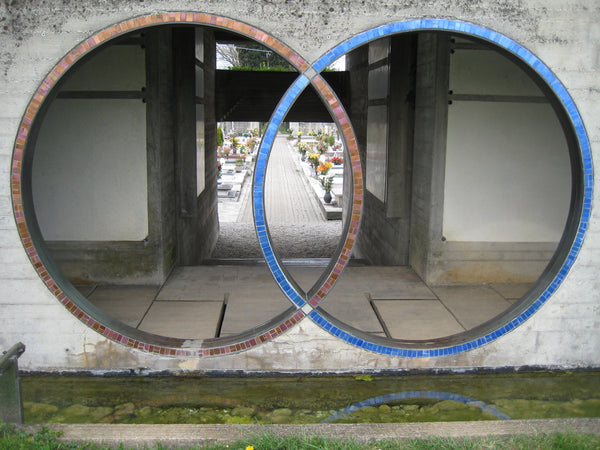by J. Malec
Photo: Brion Cemetery by J. Malec
In Part I, Memorials, Cremation Containers, Death and Design, we list seven unique themes that blend death and architecture. Our exploration highlights cremation architecture and memorial designs.
Part II amplifies themes of death expressed through unique designs and funerary areas.
Crematorium Memorials and Other Funerary Areas
Frank Lloyd Wright popularized the idea of organic architecture. His style utilizes a horizontal orientation. Many of Wright’s designs are loosely considered part of the Mission style that grew in popularity toward the end of the 19th century and maintains its popularity today.
The Mission Style Cremation Urn - Indigo is a very popular display cremation urn. It is made of hand carved pieces of stone that are stained in vibrant blue colors.
Mausoleums, columbariums and crematoriums represent a more familiar application of architecture toward addressing death. Luke Barley discusses the evolution of specially designated funerary areas:
For anyone keenly interested, Barley provides a catalog of photos from around the world. The gallery highlights cemeteries, chapels, crematoriums and gardens, including the Garden Mausoleum at Lakewood Cemetery in Minneapolis.
With renewed thoughtfulness and insight, contemporary architecture is again addressing the aesthetics of death. DesignBoom, a design community hub on the Internet, recently held a competition centered on interment titled “Design for Death.” With more than 2000 designers competing for recognition in this arena, the results were truly breathtaking in scope and imagination.
Captivating Memorial Designs
Among the brilliantly conceived entries, ‘i wish to be rain’ and the ‘Mushroom Death Suit’ caught my attention. Each one envisions a life after death, and encourages reflection on the greater web of being rather than loss as a form of isolation. The designs are a reminder that we are all in this together.
Studio PSK’s ‘i wish to be rain’ entry harnesses technology commonly used to seed clouds. It allows cremains to initiate rain, transforming death into a life-giving process. In the designer’s words, when ready “simply turn the top segment, opening a valve to a helium tank which filling [sic] a weather balloon with the buoyant gas. ... At the point it reaches the troposphere, the highest point at which clouds formed, the capsule bursts, dispersing the ashes into the clouds below.”
Jae Rhim Lee describes her “Mushroom Death Suit” as green couture for the modern postmortem body. “The Mushroom Death Suit consists of a base layer of organic cotton ... The upper layer consists of netting embedded with Infinity Mushroom spores and mycelium (the "roots" of mushrooms), which allows the Infinity Mushrooms to grow and spread across the body. … The Mushroom Death Suit addresses current social, environmental, and economic needs--for low-impact funeral options … and the desire for a more holistic relationship with nature.”
Dying, Death and Conversations
Another unique application of design in relation to death and dying is the production of an interactive card game called ‘My Gift of Grace’. Common Practice, a collaborative design company, created this project. Their work with experts in death and dying led to the design of the game that prompts meaningful conversations about living and dying well. Researchers recently found that:
74% of people who played My Gift of Grace went on to complete an advance care planning activity following the game, and 71% of players in the study advanced at least one stage of change for advance care planning behaviors such as completing a living will or talking with a loved one or clinician about their wishes. In all, 90% of participants advanced in stage of change and/or performed an advance care planning activity.
There are many benefits of “unhiding death.” By becoming more familiar with the intersection of life and death, we are better able to manage fears around death, gain perspective on where death fits into our lives, and help others to do the same. Death can be a great teacher, helping us gain compassion, humility and insight into what really matters in life.
These are just a few of many outstanding examples of how contemporary design processes are transforming the experiences we share around death and dying. Doubtless, there will be many more shining examples to come in the near future. Because of innovations like these, we may be uniquely empowered to claim the memorialization of loved ones and ourselves from the shadows and bring them into the light.
J. Malec is a visual artist and writer whose work often deals with themes related to loss and healing. She lives in Minneapolis, and spends much of her time practicing permaculture in the city.

